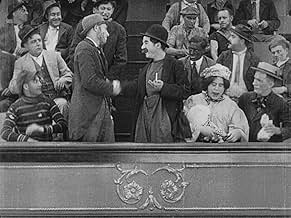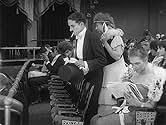Ajouter une intrigue dans votre langueMr. Pest tries several theatre seats before winding up in front in a fight with the conductor. He is thrown out. In the lobby he pushes a fat lady into a fountain and returns to sit down by ... Tout lireMr. Pest tries several theatre seats before winding up in front in a fight with the conductor. He is thrown out. In the lobby he pushes a fat lady into a fountain and returns to sit down by Edna. Mr. Rowdy, in the gallery, pours beer down on Mr. Pest and Edna. He attacks patrons,... Tout lireMr. Pest tries several theatre seats before winding up in front in a fight with the conductor. He is thrown out. In the lobby he pushes a fat lady into a fountain and returns to sit down by Edna. Mr. Rowdy, in the gallery, pours beer down on Mr. Pest and Edna. He attacks patrons, a harem dancer, the singers Dot and Dash, and a fire-eater.
- Réalisation
- Scénario
- Casting principal
- Lady in Audience
- (non crédité)
- Man in Balcony
- (non crédité)
- Ticket Taker
- (non crédité)
- …
- Man Behind Bead Lady
- (non crédité)
- First in Line
- (non crédité)
- …
- Gentleman in Audience
- (non crédité)
- Tuba Player
- (non crédité)
- Member of 'Dot and Dash'
- (non crédité)
- …
- Trombone Player and Singer
- (non crédité)
- …
- Large Boy
- (non crédité)
- Feather Duster
- (non crédité)
- …
- Lady in the Stalls
- (non crédité)
- Lady in the Stalls with Beads
- (non crédité)
- Orchestra Conductor
- (non crédité)
- Tootsy Frutti the snake charmer
- (non crédité)
- Second Man in Balcony Front Row
- (non crédité)
Avis à la une
During the first part, there are some misadventures as Charlie's characters settle into their seats, with one of his characters being the kind of chronic seat-changer that we've all had to deal with. During the second part, the show begins, and the audience and the various performers compete with each other for attention.
Chaplin used a lot of comic ideas in this one, some slapstick and some more subtle. It is also very interesting as a look (though probably exaggerated) at the kind of often off-beat live entertainment that was so popular in the days before television and radio.
This is an interesting short, and worth a look.
Mr. Rowdy (Chaplin) is an abusive drunk with an overblown mischievous streak. We learn little about him, and he's there for the laughs he provides. He does provide them, and one can imagine that he was just a fun character to play.
Mr. Pest (Chaplin), on the other hand, has the universe revolving around him. Everyone else in the theater is there for his amusement, and it strained credulity a little bit which is fine that he wasn't just thrown out of the place.
The show which Chaplin attends is intolerable until Chaplin takes matters into his own hands. Some people in the audience, you'll feel, deserve to be smacked, and of course, they are knocked around by a master.
I'm a big fan of his Keystone stuff, but "A Night at the Show" is Chaplin freed at Essanay. The world is his oyster, and he sups on seafood. It's a blast!
Of course, it's not always his fault, as in this case, he is led to the wrong seat, causing him to make his way down these crowded aisles repeatedly, upsetting more people every time. The film begins to delve into simplistic but hilarious violence as Charlie ultimately proceeds to belligerently punch everyone in sight with his characteristic roundhouse punches, bringing the whole house to their feet and having to be forcefully removed. He is seated in another section while the conductor of the band in the show (the first person he attacked) puts himself and his equipment back together in an effort to begin the rest of the show.
There is an element of foreshadowing in the film as we witness another person who is not unruly, but who is a little unstable on his feet and who resembles the Tramp far too much to be anything but a person who is going to cause some trouble at some point in the film, with the expected result that everyone will take him as the Tramp and Charlie will take the blame for whatever he does. This guy turns out to be a mildly amusing character as he cheerfully dumps a beer from the balcony onto the audience below, where the Tramp, fresh from shoving a fat lady into a tub of water, is flirting with a flapper girl who he caught eyeing him from across the room.
Not exactly the best stuff from Chaplin, but one of the funniest scenes in the film is the one in which the Tramp goes to hold the girl's hand and winds up holding the hand of her beefy date, fluttering his eyelids at her all the while, completely oblivious. He moves again when he discovers his plunder, only to begin getting himself in trouble yet again. He ultimately manages to get himself into a fight right on the stage where the show is taking place, only to be moved yet again.
Charlie seems to be more vexed than usual with people in general in this film, which is understandable near the end when he gets seated next to a horribly aggravating fat kid, as the movie is reduced to a food fight, and the show gets the biggest applause after Charlie has gone on stage to put a pie in the face of the guy singing. It's pretty clear that Charlie is making a comment with this film about the quality of the average stage production in 1915, because all of the acts in the film are pretty bad. No wonder the Tramp's upset for so much of the film.
As is pretty traditional with these early Chaplin short films, A Night in the Show does not end with much of a conclusion, but rather with another comedy skit, the grand finale, if you will. This is by far the funniest scene in the film, in which the Tramp look-alike in the balcony takes a fire hose and proceeds to hose down everyone in the auditorium. What a great scene! There are some truly great laughs in that scene, although I remain unsure about why there was a fire hose in the middle of an auditorium. I'm sure I just don't know enough about the fire standards of 1915, but regardless of why it's there, it makes a great prop for the film.
A Night in the Show is definitely not one of the best or most memorable of Chaplin's early films, but the quality is there and it is, as they all are, a cinematic curiosity piece in that it was made by one of the greatest filmmakers in the history of the medium.
From his Essanay period after leaving Keystone, 'A Night in the Show' (from my understanding it is indeed based on his vaudeville years with Fred Karno) is not one of his very best but is one of his best early efforts and among the better short films of his. It shows a noticeable step up in quality though from his Keystone period, where he was still evolving and in the infancy of his long career, from 1914, The Essanay period is something of Chaplin's adolescence period where his style had been found and starting to settle. Something that can be seen in the more than worthwhile 'The Bank'.
The story is still flimsy and actually one of the most lightweight ones of the Essanay period, there are times where it struggles to sustain the short length, and could have had more variety.
On the other hand, 'A Night in the Show' looks pretty good, not incredible but it was obvious that Chaplin was taking more time with his work and not churning out countless shorts in the same year of very variable success like he did with Keystone. Appreciate the importance of his Keystone period and there is some good stuff he did there, but the more mature and careful quality seen here and later on is obvious.
While not one of his most hilarious or touching, 'A Night in the Show' is still very funny with some clever, entertaining and well-timed slapstick and is one of his first to have substance and pathos after 'The Bank' and 'The Tramp'. It moves quickly and there is no dullness in sight. The ending is great fun.
Chaplin directs more than competently, if not quite cinematic genius standard yet. He also, as usual, gives an amusing and expressive performance and at clear ease with the physicality and substance of the role. The supporting cast acquit themselves well.
In summary, very good and one of the best from Chaplin's Essanay period. 8/10 Bethany Cox
Le saviez-vous
- AnecdotesBased on a famous comedy act called "Mummingbirds" in which Charles Chaplin starred when he was a player with The Karno Company in England.
- GaffesWhen the snake charmer is near Mr Rowdy, you can see she is barefoot. But, a shot after, she is wearing low heeled boots.
- Citations
Title Card: La Belle Wienerwurst.
- ConnexionsEdited into Chaplin's Art of Comedy (1966)
Meilleurs choix
Détails
- Date de sortie
- Pays d’origine
- Site officiel
- Langues
- Aussi connu sous le nom de
- Charlot au spectacle
- Société de production
- Voir plus de crédits d'entreprise sur IMDbPro
- Durée
- 24min
- Couleur
- Mixage
- Rapport de forme
- 1.33 : 1
































